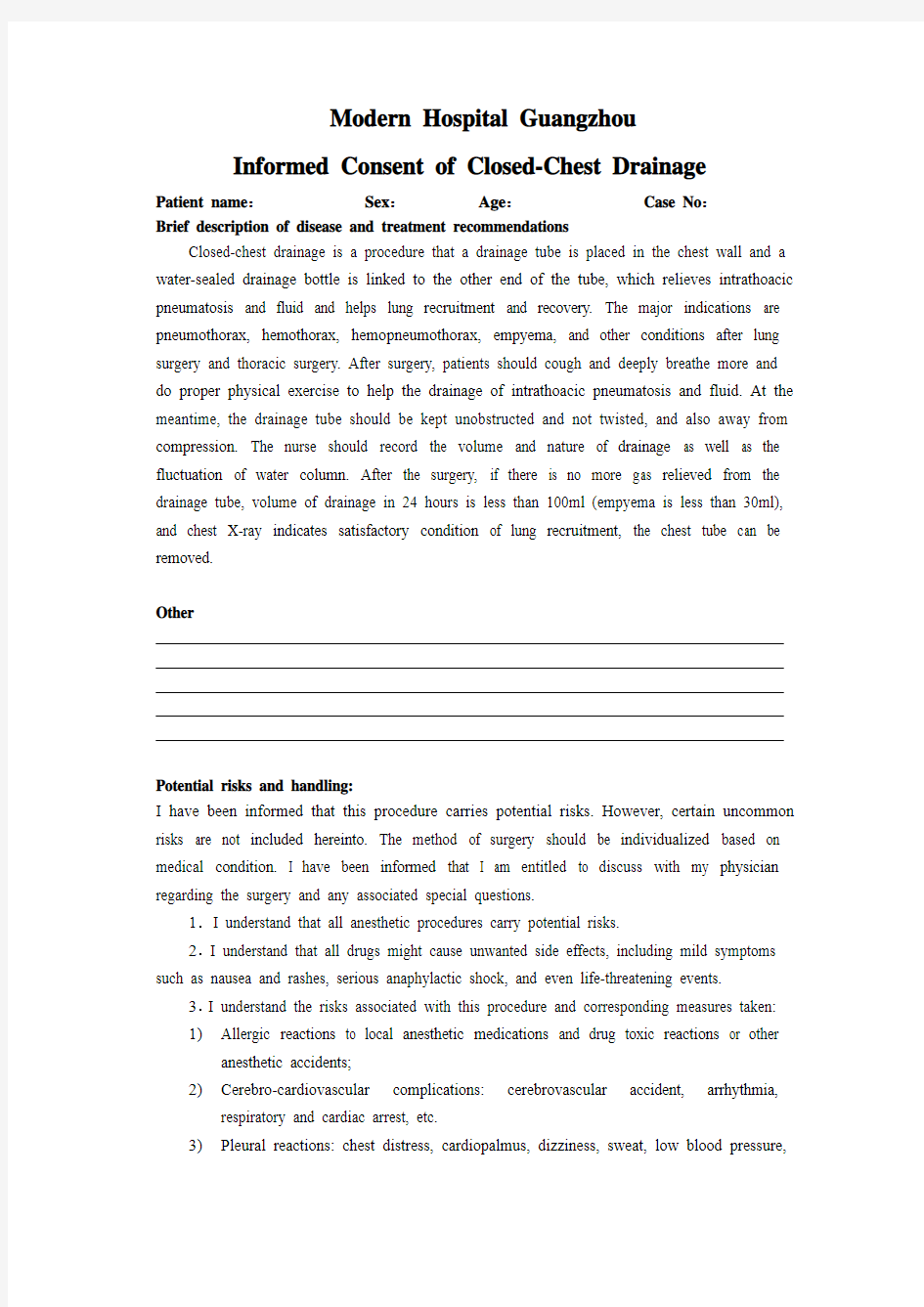En 胸腔闭式引流术知情同意书

- 1、下载文档前请自行甄别文档内容的完整性,平台不提供额外的编辑、内容补充、找答案等附加服务。
- 2、"仅部分预览"的文档,不可在线预览部分如存在完整性等问题,可反馈申请退款(可完整预览的文档不适用该条件!)。
- 3、如文档侵犯您的权益,请联系客服反馈,我们会尽快为您处理(人工客服工作时间:9:00-18:30)。
Modern Hospital Guangzhou
Informed Consent of Closed-Chest Drainage
Patient name:Sex:Age:Case No:
Brief description of disease and treatment recommendations
Closed-chest drainage is a procedure that a drainage tube is placed in the chest wall and a water-sealed drainage bottle is linked to the other end of the tube, which relieves intrathoacic pneumatosis and fluid and helps lung recruitment and recovery. The major indications are pneumothorax, hemothorax, hemopneumothorax, empyema, and other conditions after lung surgery and thoracic surgery. After surgery, patients should cough and deeply breathe more and do proper physical exercise to help the drainage of intrathoacic pneumatosis and fluid. At the meantime, the drainage tube should be kept unobstructed and not twisted, and also away from compression. The nurse should record the volume and nature of drainage as well as the fluctuation of water column. After the surgery, if there is no more gas relieved from the drainage tube, volume of drainage in 24 hours is less than 100ml (empyema is less than 30ml), and chest X-ray indicates satisfactory condition of lung recruitment, the chest tube can be removed.
Other
Potential risks and handling:
I have been informed that this procedure carries potential risks. However, certain uncommon risks are not included hereinto. The method of surgery should be individualized based on medical condition. I have been informed that I am entitled to discuss with my physician regarding the surgery and any associated special questions.
1.I understand that all anesthetic procedures carry potential risks.
2.I understand that all drugs might cause unwanted side effects, including mild symptoms such as nausea and rashes, serious anaphylactic shock, and even life-threatening events.
3.I understand the risks associated with this procedure and corresponding measures taken:
1)Allergic reactions to local anesthetic medications and drug toxic reactions or other
anesthetic accidents;
2)Cerebro-cardiovascular complications: cerebrovascular accident, arrhythmia,
respiratory and cardiac arrest, etc.
3)Pleural reactions: chest distress, cardiopalmus, dizziness, sweat, low blood pressure,
and shock, etc.
4)Local bleeding, effusion, errhysis, infection, or hematoma in incision site of chest
wall.
5)Injuries to intercostal blood vessels and lungs during the surgery, pneumothorax,
hemothorax, pneumohemothorax, subcutaneous emphysema after the surgery, or even
surgical procedures (thoracoscope or thoracotomy) will be adopted in critical
condition.
6)Tight adhesion of thoracic cavity found during the surgery results in unsuccessful
insertion of drainage tube ;
7)Poorly location of drainage tube and inadequate drainage may result in adjustment or
reinsertion of drainage tube.
8)Breaking, retention and obstruction of puncture needle or drainage tube;
9)Reexpansion pulmonary edema after surgery, and life-threatening risk in critical
condition.
10)After the surgery, large amounts of fluid drained continuously, gas leaked
continuously, or dissatisfactory lung recruitment, results in drainage tube remaining
for long time.
11)Injuries or stimulus to intercostal nerves result in pain and numbness after surgery;
12)Injuries to other organs in the abdominal cavity, in severe cases, surgery is required;
13)Infection of incisional wound and fat liquefaction result in undesirable or delayed
healing of wound;
14)Skin necrosis, sinus tract formation, and pleural adhesions in drainage tube site;
Delayed union or even disunion of wound and esthetic effection after pulling out the
tube.
4.I understand that patients with hypertension, heart disease, diabetes, renal insufficiency, venous thrombosis, etc or with a smoking history might have increased risks described above, or experience worsening of associated medical condition or episodes of cerebro-cardiovascular accident, even death during surgery or postoperatively.
5. I understand that if I don’t follow doctor’s order or in an inappropriate position, surgical effect may be affected.
Special risks or major high-risk factors
I understand that the following special complications or risks may occur under current medical condition, apart from the forementioned situations:
